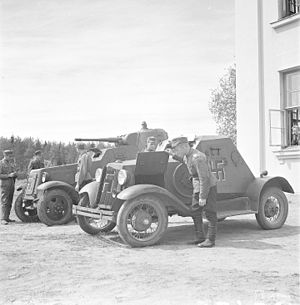D-8 armoured car
| D-8 (Dyrenkov-8) | |
|---|---|

D-8 Armored Car captured by the Finnish Army during the Winter War
|
|
| Type | Armored car |
| Place of origin |
|
| Service history | |
| In service | 1931-1940 |
| Used by | Soviet Union, Finland, Spain |
| Wars | Spanish Civil War, Winter War |
| Production history | |
| Designer | N.I. Dyrenkov |
| Manufacturer | Izhorskiye Factory |
| No. built | around 25 |
| Specifications | |
| Weight | 1.58 tons |
| Length | 3,540 mm (139 in) |
| Width | 1,705 mm (67.1 in) |
| Height | 1,680 mm (66 in) |
| Crew | 2 |
|
|
|
| Armor | 3 mm (0.12 in) on roof, 6 mm (0.24 in) rear and 7 mm (0.28 in) front |
|
Main
armament |
2 × 7.62 mm (0.300 in) DT machine guns |
| Engine | GAZ-A petrol 40 hp (30 kW) |
| Transmission | Mechanical |
| Suspension | Spring hanger |
| Ground clearance | 224 mm (8.8 in) |
|
Operational
range |
225 km (140 mi) |
| Speed | 85 km/h (53 mph) |
D-8 (Dyrenkov-8) was an early Soviet armored vehicle built in 1932–34. Only around 25 were built; it was quickly superseded by the FAI armoured car. Both were assembled in the Izhorsky Factory near Leningrad.
As a result of their extensive experience with armored cars during the Civil War, the Soviets showed a great deal of interest in developing more modern versions during the 1930s. However, their initial efforts were slowed until the rejuvenation of the Russian automobile industry which began in the late 1920s. The Soviets saw the armored car as falling into two primary classes; light and heavy. This classification was based more on armament than on weight. Light armored cars were armed with machine guns while heavy armored cars were armed with 37 to 45 millimetres (1.5–1.8 in) tank guns.
The earlier armored car designs, such as the BA-27, were based on a truck chassis. Following the BA-27 project, the next projects were undertaken at the Izhorskiye Factory in Kolpino on the basis of newly imported Ford Model A automobiles, and their Soviet copies, the GAZ-A. The chassis for most armored cars of the 1930s were built by the KIM plant in Moscow and the Gorkiy plant in Nizhny Novgorod. The latter plant was originally known as the Nizhny Novgorod Automobile plant (NAZ), but was renamed as the Gorkiy Automobile Plant (GAZ) in the mid-1930s. These chassis were shipped to the armored car manufacturers (primarily the Izhorskiy and the smaller but longer established Vyksinskiy plant), where the armored bodies were mounted on the chassis and final assembly was undertaken. Prior to 1931, the imported Ford Timken chassis was used for some Soviet armored cars. While this chassis was available thereafter, the provision of series production technology to the USSR by Henry Ford in 1931-32 gave a major boost to Soviet armored car production. It provided readymade chassis for both light (Ford/GAZ-A and Ford/GAZ-AA-based) and heavy (GAZ-AAA-based) armored cars. ZiS was also later to provide 6×4 chassis for limited production heavy armored cars.
The D-8 Armored vehicle, designed in 1931 by N. I. Dyrenkov, was relatively light and had no turret. The design utilized a licensed passenger car Ford A chassis. Two machine guns were used on hull's sides, not providing a 360-degree coverage. The D-8 had a two-man crew sitting back to back so that the rear man could fire a rear-mounted machine gun. In 1932, the D-8 was upgraded with small turrets and had the DT machine gun mounted in it in order to reduce the vehicle's vulnerability. The D-8 was quickly phased out of production in lieu of the heavier and better equipped FAI armoured car.
...
Wikipedia
